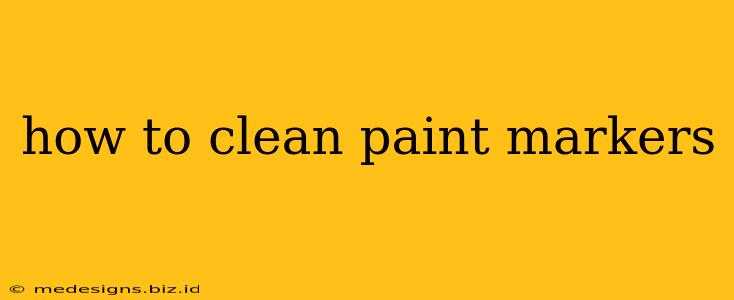Paint markers are fantastic tools for artists, DIY enthusiasts, and crafters alike. Their vibrant colors and precise application make them perfect for a variety of projects. But what happens when you're finished? Cleaning paint markers effectively is crucial to maintain their lifespan and prevent accidental staining. This comprehensive guide covers various methods for cleaning different types of paint markers, ensuring your tools stay in top condition.
Understanding Your Paint Marker
Before diving into cleaning methods, it's important to identify the type of paint marker you're working with. Different inks require different cleaning techniques. Common types include:
- Acrylic paint markers: These are water-based and generally easier to clean.
- Oil-based paint markers: These are more durable and require stronger solvents for cleaning.
- Alcohol-based paint markers: These are known for their quick-drying time and may require alcohol-based cleaners.
Knowing the type of ink will significantly impact your cleaning strategy. Always check the marker's packaging for specific cleaning instructions from the manufacturer.
Cleaning Methods for Different Surfaces
The surface the paint marker has been used on also plays a vital role in cleaning. Here's a breakdown of effective techniques for various surfaces:
Cleaning Paint Markers from Fabric:
For fresh stains: Act quickly! Blot (don't rub) the stain with a clean cloth to lift as much paint as possible. Then, apply a small amount of laundry detergent directly to the stain and gently work it in. Launder as usual. For stubborn stains, consider using a stain remover specifically designed for paint.
For set stains: Pre-treat the stain with a stain remover before washing. For acrylic paint markers, you might try soaking the fabric in warm, soapy water. For oil-based markers, a stronger solvent like rubbing alcohol might be necessary (always test in an inconspicuous area first!).
Cleaning Paint Markers from Skin:
Water-based paints: These are usually easy to remove with soap and water. Gently wash the affected area.
Oil-based paints: These can be trickier. Try using baby oil or vegetable oil to break down the paint. Rub gently and then wash with soap and water. Stubborn stains might require a stronger solvent like nail polish remover (acetone-based) but use with caution and test on a small area first.
Important Note: Always wear gloves when working with solvents to protect your skin.
Cleaning Paint Markers from Other Surfaces:
- Glass and Plastic: For acrylic paint markers, warm, soapy water is usually sufficient. For oil-based markers, isopropyl alcohol may be needed. Always test a small, inconspicuous area first.
- Metal: Depending on the type of paint and the metal's finish, a variety of cleaning methods may be used, from soapy water to specialized metal cleaners.
- Wood: For water-based markers, you can use a damp cloth and soap. For oil-based, a solvent might be necessary. Always test on an inconspicuous area first to avoid damaging the finish.
Maintaining Your Paint Markers
Proper maintenance will extend the life of your paint markers. Here are a few tips:
- Store Properly: Keep paint markers in a cool, dry place, away from direct sunlight and extreme temperatures.
- Shake Well: Before each use, shake the marker vigorously to mix the ink properly.
- Cap Tightly: Always cap the markers tightly after each use to prevent the ink from drying out.
- Regular Cleaning: Clean the nib regularly to prevent clogging. Use a damp cloth or cotton swab to remove any dried paint.
Safety First!
Always work in a well-ventilated area, especially when using solvents. Wear appropriate safety gear such as gloves and eye protection when necessary. Always test any cleaning solution on a small, inconspicuous area before applying it to the entire surface.
By following these tips and understanding the specific needs of your paint markers, you can keep your tools clean and ready for your next creative project. Remember, patience and the right technique are key to successfully cleaning paint markers from various surfaces.
